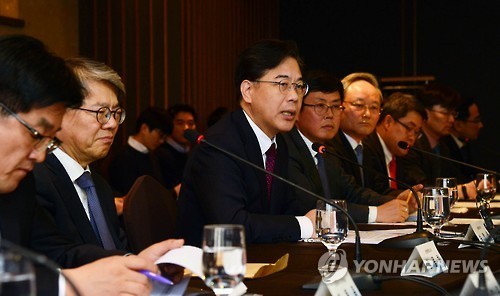The country will draw up mid- and long-term measures to cope with expected deterioration in the financial health of the country's key national insurance schemes and major national pension funds as they are expected to run into the red in the coming years due to the rapidly aging of the country's population, the finance ministry said Tuesday.
The National Health Insurance Service, which logged a net profit of 3.1 trillion won ($2.7 billion) in 2016, will likely swing to a deficit in 2018 and its reserves of 21 trillion won be depleted by 2023, according to the Ministry of Strategy and Finance.

Employment Insurance is also forecast to suffer a deficit from 2020 that will reach an estimated 2.6 trillion won by 2025, while Long-Term Care Insurance already posted a deficit of 40 billion won in 2016.
"The government will go through a mid-term fiscal assessment of the three insurance plans and come up with measures to improve their balance sheets," Vice Finance Minister Song Eon-seog said.
He added that the government will also conduct a thorough financial assessment of four national pension funds including the National Pension Service as the country is experiencing a rapid demographic change.
South Korea is widely expected to become an aged society in 2018, meaning that the percentage of seniors will reach more than 14 percent of the entire population, and a super-aged society in 2025 with the figure going up to 20 percent.
The finance ministry said it will look into how this changed composition of the country's population will affect the balance sheets of these state-run insurance schemes and pension funds.
Meanwhile, seven public pension schemes, including the NPS, the Government Employees Pension Service, the Korea Teachers Pension and the Military Pension Service, had a combined 620 trillion won in reserves as of end-2016, with an average investment return of 4.6 percent.
The NPS, one of the world's largest institutional investors, has 558 trillion won in reserves, with an investment yield rate of 4.7 percent last year.
According to a separate forecast carried out in 2013, the NPS is expected to go into the red in 2044 and to be exhausted in 2060. (Yonhap)







![[Graphic News] More Koreans say they plan long-distance trips this year](http://res.heraldm.com/phpwas/restmb_idxmake.php?idx=644&simg=/content/image/2024/04/17/20240417050828_0.gif&u=)
![[KH Explains] Hyundai's full hybrid edge to pay off amid slow transition to pure EVs](http://res.heraldm.com/phpwas/restmb_idxmake.php?idx=644&simg=/content/image/2024/04/18/20240418050645_0.jpg&u=20240419100350)





![[From the Scene] Monks, Buddhists hail return of remains of Buddhas](http://res.heraldm.com/phpwas/restmb_idxmake.php?idx=652&simg=/content/image/2024/04/19/20240419050617_0.jpg&u=20240419175937)

![[KH Explains] Hyundai's full hybrid edge to pay off amid slow transition to pure EVs](http://res.heraldm.com/phpwas/restmb_idxmake.php?idx=652&simg=/content/image/2024/04/18/20240418050645_0.jpg&u=20240419100350)

![[Today’s K-pop] Illit drops debut single remix](http://res.heraldm.com/phpwas/restmb_idxmake.php?idx=642&simg=/content/image/2024/04/19/20240419050612_0.jpg&u=)